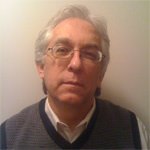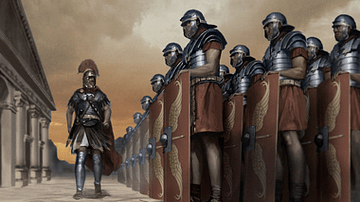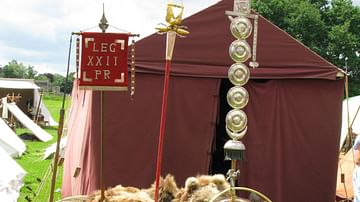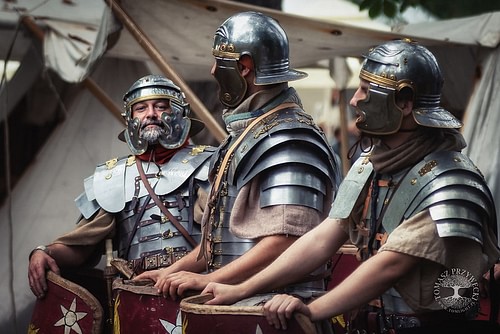
Legio XXI Rapax was a legion of the Roman army whose name name "Rapax" means "rapacious" or "greedy". It is not clear when the legion assumed this name; it may or may not be the same 21st legion Julius Caesar (100-44 BCE) formed before his Gallic Wars and the 21st commanded by Mark Antony (83-30 BCE). Roman emperor Augustus (r. 27 BCE - 14 CE) also formed 21st.
In his Histories, the Roman historian Tacitus (l. c. 56 - c. 118 CE), who reportedly commanded the Rapax legion from 89 to 92 CE, called it "a corps of old and distinguished renown." (II. 43) Aside from its participation in a mutiny in 14 CE, the Legio XXI Rapax served with distinction at the First Battle of Bedriacum, at the Battle of Rigodulum during the Batavian Revolt, and at Vetera (Old Camp) before it was massacred by the Sarmatians in Dacia in 92 CE.
The Legion’s Formation
Early legions were identified by a number, not a name. So, the legion of both Caesar and Octavian may or may not have been the legion that later became known as XXI Rapax. There is some indication that Octavian retained a 21st that served with him at the Battle of Actium against Antony and Cleopatra in 31 BCE, and there is evidence that he later formed a 21st legion for his conquest of the Alps and the Cantabrian campaigns in Hispania (27-19 BCE).
After 15 BCE, the 21st was stationed in Raetia situated on the Danube River. In 6 CE, it was in preparation to be part of the Roman commander and future emperor Tiberius’ (r. 14-37 CE) abandoned campaign against the Marcomanni. After Publius Quinctilius Varus lost three legions in the Battle of Teutoburg Forest in 9 CE, Legio XXI Rapax was transferred to the Lower Rhine at Vetera (modern-day Xanten), sharing the fortress with Legio V Alaudae. After helping suppress the Pannonian Revolt, the 21st took part in Germanicus’ campaign against the Chatti in 14 CE.
The Mutiny
However, earlier in 14 CE, before the XXI Rapax served under Germanicus, it was an instigator in a mutiny, citing poor conditions, most importantly pay and terms of service. Like the other legions of the Rhine frontier, the XXI Rapax was displeased with Tiberius as successor to Augustus, supporting Germanicus instead, who was in Gaul at the time. The legions had sworn allegiance to Augustus, not the Roman state; therefore, a new emperor served as the ideal time for an increase in pay. When Tiberius’ son Drusus was unable to pacify the legions, he called upon his adopted son Germanicus. In his Annals Tacitus wrote of the legions’ initial concerns in the mutiny:
… the legions of Germany rose in mutiny, with a fury proportioned to their greater numbers, in the confident hope that Germanicus Caesar would not be able to endure another’s supremacy and would offer himself to the legions, whose strength would carry everything before it. (Annals I. 31)

The legions of the Lower Rhine, which included V Alaudae and XXI Rapax, served under the commander Aulus Caecina. These two legions were the principal leaders of the mutiny. Tacitus noted how the legions of the Upper Rhine "with minds in suspense" watched the mutiny from elsewhere but "…the soldiers of the lower army fell into a frenzy, which had its beginnings in the men of the twenty-first and fifth legions and into which the first and twentieth were also drawn" (Annals I. 31). Upon his arrival, Germanicus was able to placate the demands of several of the mutinous legions. Tacitus wrote of the instigators’ rejection of all concessions:
Quiet being thus restored for the present, a no less formidable difficulty remained through the turbulence of the fifth and twenty-first, who were in winter quarters sixty miles away at Old Camp… These, in fact, has been the first to begin the mutiny, and the most atrocious deeds had been committed by their hands. Unawed by the punishment of their comrades, and unmoved by their contrition, they retained their resentment.” (Annals I. 45)
While the mutinous legions listened to Germanicus and realized these concessions were hastily improvised, they still demanded their immediate implementation. The cash payments, however, were held up until the troops reached their winter quarters. While most of the legions understood, this was not the case with the legionaries of the fifth and twenty-first who refused to move from their quarters until the whole sum was paid. Finally, Germanicus gave Caecina an ultimatum: execute the principal mutineers or he would resort to a criminal massacre. Caecina did as he was told. With a force of loyal legionaries, Caecina entered the mutineers’ tents and killed the offenders. Germanicus called the commander’s solution a catastrophe and ordered the bodies to be cremated.
Germanicus' Campaign
The XXI Rapax and V Alaudae were able to redeem themselves with Germanicus during his German campaign. The Germans had taken advantage of the dissension among the legions, but the Roman commander roused his legions, crossed the Rhine, and marched against them. He organized his legions with the 21st and 5th in the center and on the right:
Part of the cavalry and some of the auxiliary cohorts led the van; then came the first legion, and, with the baggage in the centre, the men of the twenty-first closed up the left, those of the fifth, the right flank. The twentieth secured the rear, and, next were the rest of the allies. (Annals I. 51)
The Germans were no match for the efficiency of the Roman military. "At a single dash they [The Romans] broke through the enemy, and drove him back with great slaughter into the open country." (I. 51)
Battle of the Long Bridges
At the end of Germanicus’ victorious campaign, as the commander returned by fleet, Caecina was ordered to return to the Rhine by taking a narrow route that lay amid a vast swamp, an area occupied by German tribes. Commanding four legions, Legio I Germanica, Legio V Alaudae, Legio XX Valeria Victrix, and Legio XXI Rapax, Caecina soon led them into a near-fatal battle. At the Battle of Long Bridges, they would encounter the Cherusci under the command of Arminius, who led the German forces against the Romans at Teutoburg. According to Tacitus, Caecina was fearless and had prepared his legions for any possibility. He wrote, "The legions had their assigned places, the fifth on the right wing, the twenty-first on the left, the men of the first to lead the van, the twentieth to repel pursuers" (Annals I. 64). Having been built decades earlier, the bridges they had to use were old and in terrible shape. As the legions made camp and prepared to rebuild them, the Germans took the opportunity to attack. The legions were forced into an unexpected defense of their camp.
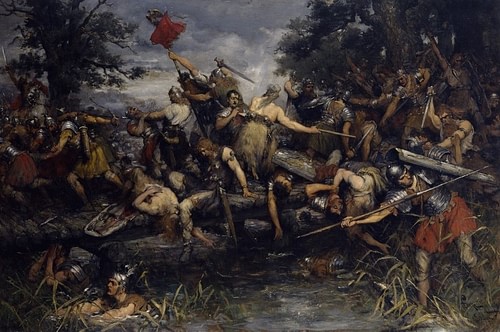
The night brought some peace for the Romans, but at daybreak, the Germans renewed their attack on the Roman camp. Chaos followed, but Caecina was able to rally his men. Although the Germans fought hard "… with a shout and sudden rush, our [Caecina's] men threw themselves on the German rear, with taunts …." (Annals I. 68) While the leaders fled, their followers were slaughtered. Historian Stephen Dando-Collins wrote in his Legions of Rome: "When Caecina’s four legions finally reached the Rhine, bloodied, filthy, hungry and exhausted, they came without their baggage and carrying severely wounded comrades on hastily improvised litters" (265).
Year of the Four Emperors
The legion remained at Vetera (Xanten, Germany) until 43 CE when it was transferred to Vindonissa (Windisch, Switzerland). While there, along with V Alaudae, I Germanica, and XX Valeria Victrix, it would put down a rebellion led by the Turoni and Treveri in Gaul. With Emperor Claudius’ (r. 41-54 CE) planned invasion of Britain, the 21st was transferred to Germania Superior (Upper Germany), replacing Legio X Gemina. It did not participate in the invasion in the end, but it later supplied 2,000 legionaries, replacing the men of Legio IX Hispana lost in the revolt of Boudicca in 60-61 CE.
Although four cohorts short, during the Year of the Four Emperors (69 CE), the legion, along with cohorts of I Germanica, IV Macedonica, V Alaudae, and XV Primigenia, sided with the governor of Germania Inferior (Lower Germany), Vitellius. The legions marched against Emperor Otho (r. 69 CE) in the First Battle of Bedriacum. During the battle, XXI Rapax and Legio I Adiutrix clashed. Both Tacitus and the Greek historian Plutarch (c. 45-50 CE - c. 120-125 CE) recalled the legions’ encounter. Writing of the 1st legion's capture of the 21st's eagle, Tacitus called the 1st high-spirited and eager and said:
On the side of Vitellius was the 21st, called the Rapax, …On that of Otho was the 1st, called Adjutirx, which had never before been brought into the field…. The men of the 1st, overthrowing the foremost of the 21st, carried off the eagle. The 21st infuriated by the loss, not only repulsed the 1st, and slew the legate, Orfidius Benignus, but captured many colours and standards from the enemy. (Histories II. 43)
Writing several decades after the battle, Plutarch wrote of the meeting between the two legions in his biography of Otho. Being critical of the Rapax, he considered the men of the legion to be old and past their strength.
There were but two legions, one of Vitellius’ called the Ravenous, and one of Otho’s called the Assistant, that got into the open outspread level and engage in proper form. Otho’s men were strong and bold, but had never been in battle before. Vitellius had seen many wars but were old and past their strength. So Otho’s legion charged boldly … and took the eagle… til the others, full of rage and shame returned the charge, slew Orfidius, the commander of the legion, and took several standards. (Lives, 1179-80)
Like its fellow legions, the Rapax was not so fortunate at the Second Battle of Bedriacum, losing to the forces of Vespasian (r. 69-79 CE). As with the other legions on the losing side, XXI Rapax was transferred to Illyricum, only to be recalled to help suppress the Batavian Revolt of Julius Civilis in 69-70 CE. XXI Rapax fought successfully against Civilis and his allies at Rigodulum, Augusta Treverorum (Trier), and Vetera. Afterwards, the legion was sent to Bonna (Bonn) in Germania Inferior (Lower Germany), replacing I Germanica. While there, the Rapax received new recruits, replacing the ones lost to the IX Hispana about a decade earlier. The legion returned to Germania Superior (Upper Germany) to participate in Emperor Domitian’s (r. 81-96 CE) campaign against the Chatti in 83 CE. Based at Moguntiacum (Mainz) with Legio XIV Gemina, XXI Rapax, along with XIII Augusta and XI Claudia, supported the failed rebellion of Lucius Antonius Saturninus in 89 CE against Emperor Domitian. Afterwards, the emperor declared that no two legions would occupy the same base.
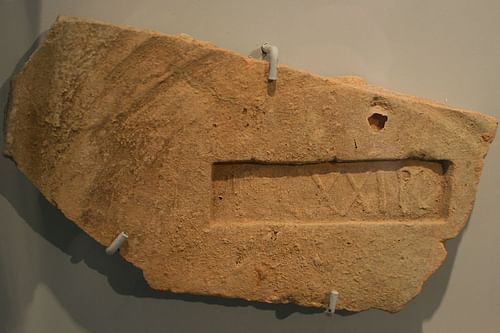
The Massacre
Shortly after coming to power, Domitian led a successful campaign against the Chatti, awarding himself the title of Germanicus. Later, the emperor’s campaign in Dacia earned him disdain, not fame. It was during Domitian’s campaign against the Sarmatians in 92 CE, that the XXI Rapax was massacred. The unpopular and vain Domitian was always seeking recognition for his military success, and the loss of a legion would not impede his claim for fame. Suetonius in his Twelve Caesars wrote:
…some of Domitian’s campaigns, that against the Chatti for instance, were quite unjustified by military necessity, but not so that against the Sarmatians, who had massacred a legion and killed its commander … he celebrated a double triumph over the Chatti and Dacians but he did not insist on recognition of the Sarmatian campaign… (299)
There are those who believe the Rapax was not massacred but either surrendered and taken away in chains to serve as slaves or was disbanded after the revolt of Saturninus. Regardless, the legion met a disastrous ending after serving the Roman Empire with distinction.
